SV Bonlanden is a Sunday League club in the greater Stuttgart area.
They currently play in the second-to-last division of organised German football.
I’m currently working five minutes away from their training ground and it’s absolutely beautiful there, but the club is still irrelevant to world football, or is it?
The club’s decent infrastructure is due to its 15-year history in the Oberliga, the fifth German division.
The former Bonladen manager, Norbert Stippel, whom I’ve worked under previously, made a huge decision in 2010 to hire Alexander Blessin as a player-assistant manager.
After Red Bull bought a club in Leipzig, it decided to implement Ralf Rangnick’s philosophy there as well.
It hired many youth coaches from the Stuttgart area, where Rangnick is from, to work in its academy, and Blessin was one of those coaches.
After many years as Robert Klauß‘s assistant, Blessin ultimately became the head coach of the U17 and, a year later, the U19 teams.
In 2020, the then-47-year-old manager decided to take his first step into professional football.
He became manager of KV Oostende in Belgium and finished fifth in his debut season with the small club.
After an unsuccessful stint at FC Genoa in Italy, Blessin returned to Belgium in 2023.
He went on to manage Royal Union Saint-Gilloise, where he won his first silverware.
At the same time, after getting promoted, Hamburg-based FC St. Pauli lost their young manager, Fabian Hürzeler, to Premier League Brighton & Hove Albion and were, therefore, looking for a new man on the sideline.They ultimately decided to hire Blessin.After losing not only their coach but also three very important players, Eric da Silva Moreira (Nottingham Forest), Marcel Hartel (St. Louis), and Aljoscha Kemlein (Union Berlin), the club faced a harsh season in the German top flight.
Still, Blessin is managing to keep his team out of the relegation zone.
After 14 games, they are currently in 15th place in the Bundesliga.
In this tactical analysis and head coach analysis, we will examine the type of football Blessin has brought to St. Pauli, which is very good even at the Bundesliga level, and what struggles are holding them back from being in a better position heading into the winter break.
Pressing Mastermind
As stated in the opening part of this piece, Alexander Blessin spent the majority of his learning years at RB Leipzig, where he was exposed to the Rangnick idea of football with high intensity and a focus on counter-pressing immediately after a loss.
Blessin has brought many Red Bull-influenced ideas to his team, especially at his first club in the men’s game.
In an interview on the official club website, he stated that he does not value much control in possession but rather prefers intensity and pressing against the ball as the key parts of his philosophy.
While many coaches say things like that, especially when they have a past at a Red Bull club, they are often unable to press their team in games effectively.
Overall, the focus on the work against the ball can be seen in the way St. Pauli is playing so far this season.
With just under 19 expected goals against, Blessin’s men rank fifth in the Bundesliga in that regard, which shows their proficiency in defending.
Interestingly enough, the team ranks below average in passes per defensive action and challenge intensity, but this is explained by the fact that the team is defending very well in a deep block on a regular base.
Still, what sets St. Pauli apart from other teams in the Bundesliga this season is their very active approach against the ball.
Even while defending in a deeper block, the team still always has a clear plan of how, when, where and whom to press in every situation that happens during the game.
Blessin always prepares the St. Pauli players very well.
They always make multiple tiny adjustments in their press that allow them to be effective against a variety of ideas that Bundesliga coaches have implemented in their teams’ build-up play.
This was once again evident during the 90 minutes of their game against Werder Bremen.
Werder Bremen is a team that prefers to build up with a lot of short passes, keeping passing distances low and involving their goalkeeper heavily in their passing game.
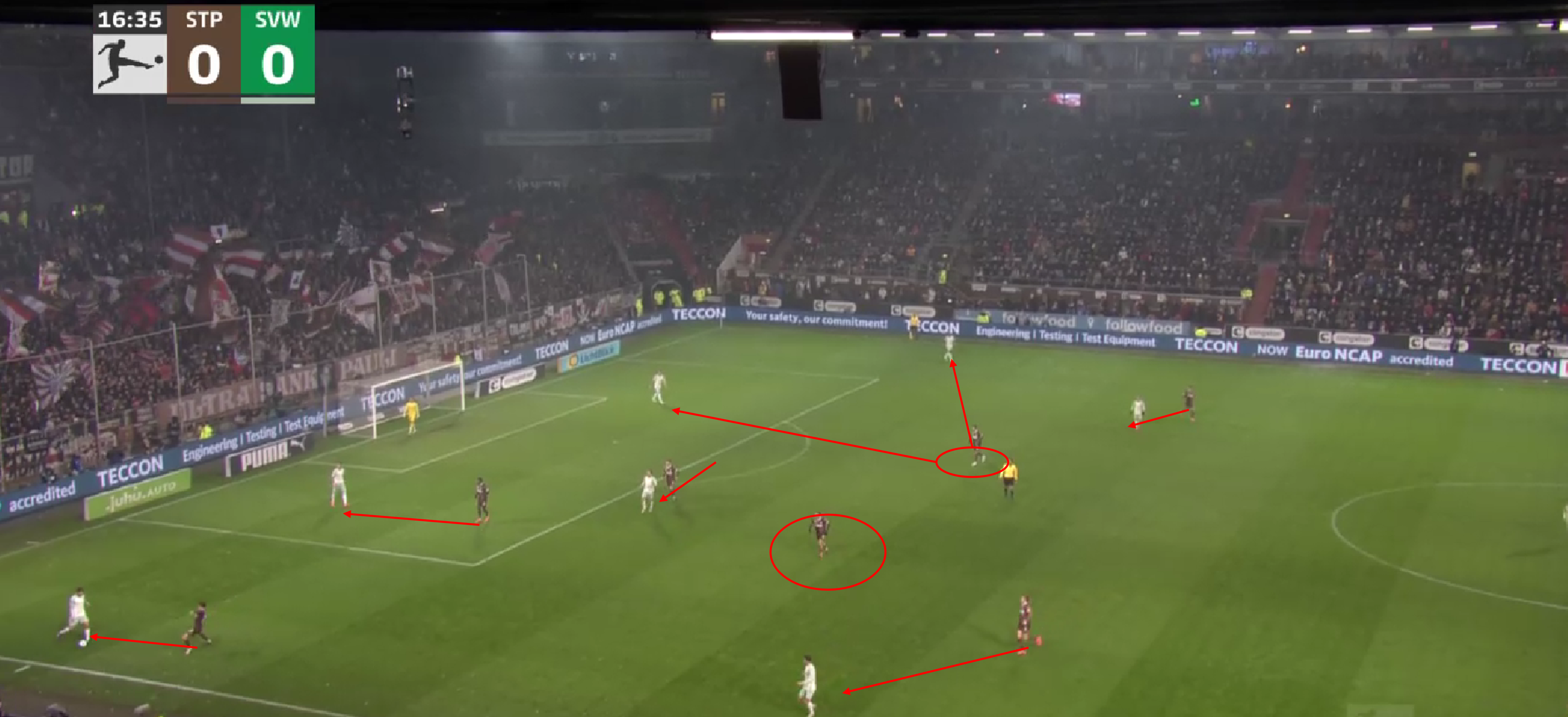
As we can see, Werder is stretching out their defensive line to create a back-four in these situations, creating a numbers advantage in the first line of play against St. Pauli’s 3-4-3 formation.
Werder now open the play with a pass to one of their centre-backs, simultaneously triggering St. Pauli’s attacking press.
There are now multiple things that Blessins’s men are doing exceptionally well from here on out.
Looking at their orientation here, St. Pauli uses a hybrid man-oriented and zonal marking press, which benefits them in different ways.
For one, by man-marking all of the near-sided players, Werder does not have an open passing option anywhere on that side of the field.
Werder usually play around the back, which allows St. Pauli to control the direction of play as well.
St. Pauli immediately eliminate Werder’s numerical advantage by cutting off the two far-sided defenders and the goalkeeper.
Now, they can move one player to the far side to control two players, which allows Blessin to free up Irvine in the middle and press quickly anywhere on the pitch if a trigger occurs.
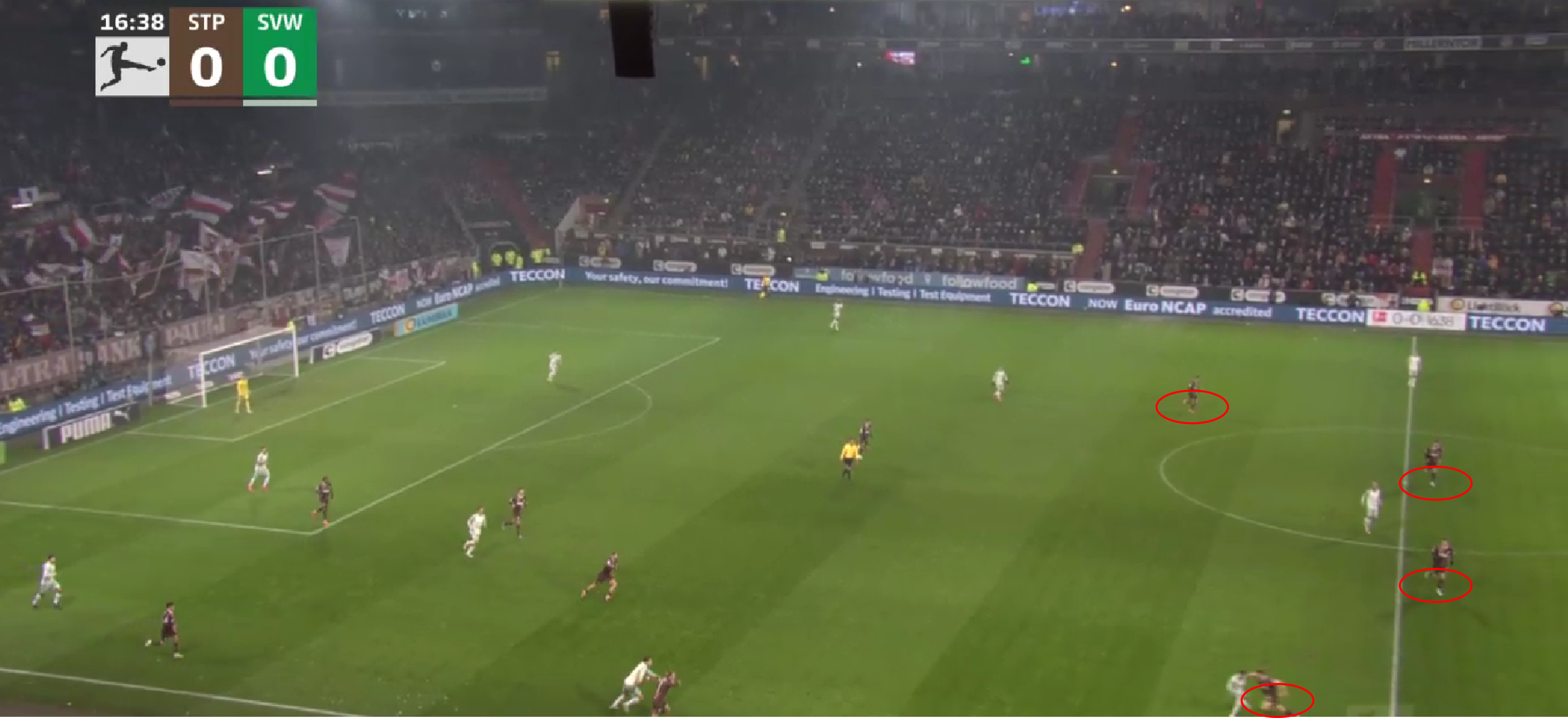
Werder now play a pass down the line, which St. Pauli are also prepared for.
Blessin’s men are doing exceptionally well at regaining a deeper position after their first line of the press is played through or over.
In their defensive line, they are prepared for the long ball.
As in their attacking line, they are committing to the near side of the pitch.
While this leaves one player open at the halfway line, St. Pauli know that a switch does not threaten them and can, therefore, always react in time if this player receives the ball.
The near-sided Werder attacker receiving the ball here is also man-marked.
Therefore, he has to work with his back towards the goal, and instant pressure prevents him from turning or finding a solution to the situation.
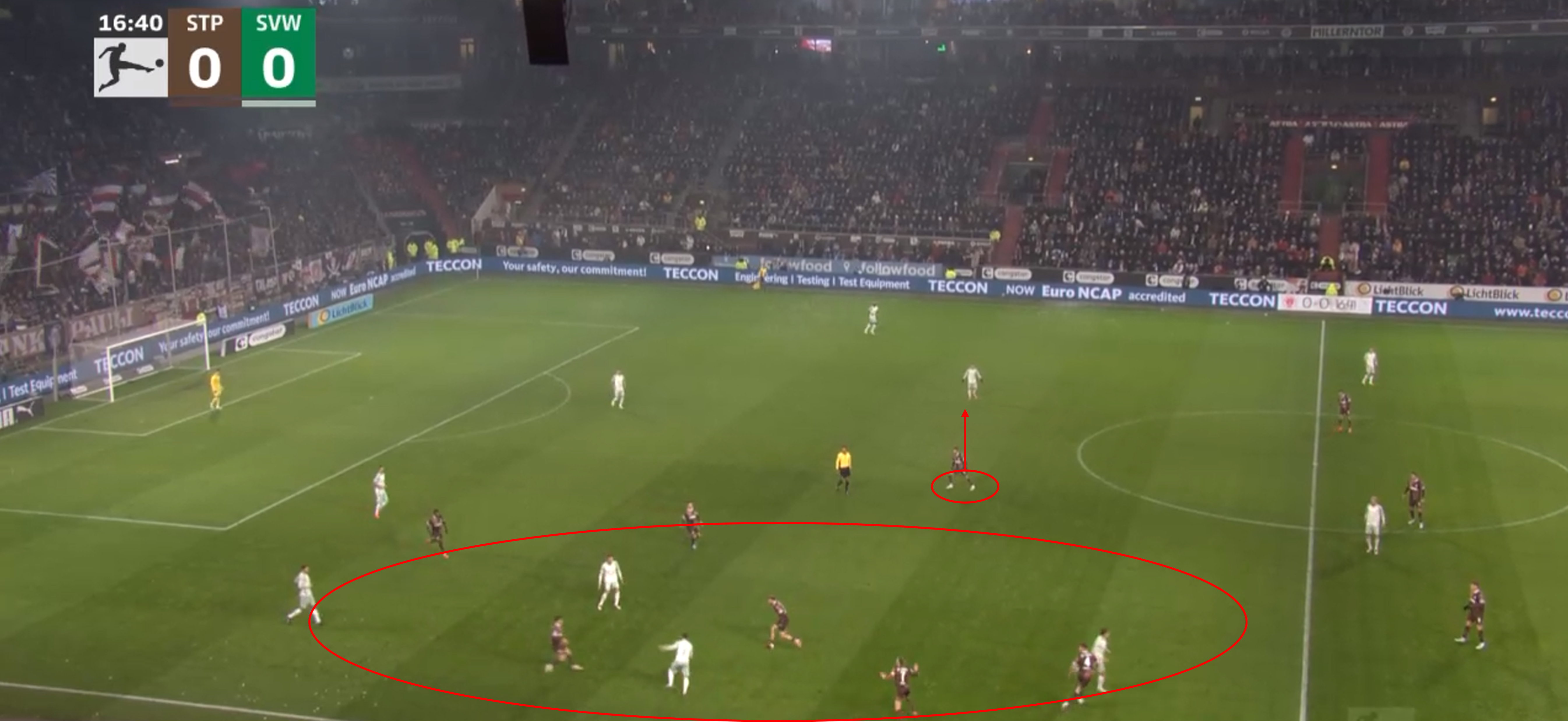
This leads to a backward pass from the Werder player, which is exactly what the St. Pauli players wanted here.
It gave them enough time for their right wing-back to recover and move back into the defensive line, so the team now has a numbers advantage there again.
The pass is also forced into a zone, where Blessin and the free man Irvine have created a numbers advantage for his team.
Werder now has to play a 4v6 situation in a condensed space, which gives Blessin’s men the edge and allows them to win the ball.
These situations have occurred in every St. Pauli game this season, against every opponent, even the top teams.
The team does really well with the way they are actively pressing to win the ball, and their counterpress is decent.
Blessin tactics makes tiny adjustments and has his team 100% committed to their workload, which pays off in many ways.
This is why St. Pauli have been so good against the ball this season.
Attacking Void
Now that we have talked about what St. Pauli does really well so far this season, we need to address the other part of the game as well, where the team has been struggling a lot.
Alexander Blessin’s men have only created 12.85 expected goals in 14 games this season, ranking dead last in that regard.
They also do not finish their rare opportunities well.
With just 11 goals scored so far this season, they are tied for last place with VfL Bochum in goals scored.
Considering the reasons for their struggles, we once again need to divide the possession phase into three parts: the build-up phase, the transition phase, and the attacking phase.
The statistics show that Alexander Blessin’s team is actually rather decent in possession.
They have a good passing rate, a lot of progressive and long passes, and decent passes per defensive action against his men; the manager seems to have a decent team in possession.
Unfortunately, the statistics don’t tell the whole story here for the boys in brown.
Taking a look at what they are doing, we need to start with the build-up.
Over the last couple of years under Fabian Hürzeler, St. Pauli excelled in this area compared to the competition in the 2. Bundesliga, which ultimately led to their promotion to the Bundesliga this summer.
A couple of things remained the same under Blessin, but he also established his identity in St. Pauli’s build-up.
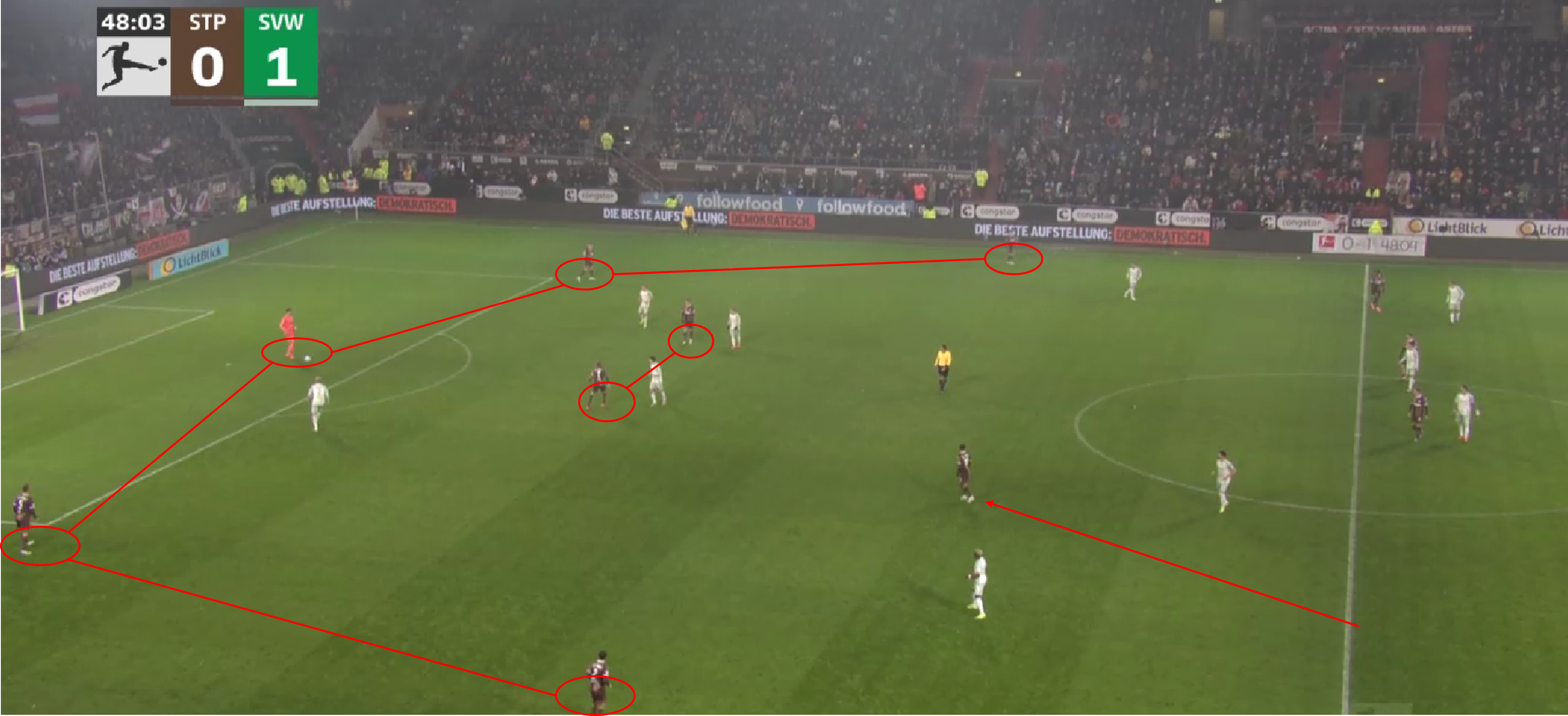
Here, we can see their typical structure when they are in control of possession.
Most of the time, it’s a 1-2-4-4 formation.
The middle centre-back, Smith, pushes into the midfield and forms a double pivot.
The goalkeeper moves forward to form a back-three again, and one of the central midfielders moves into the attacking line as a second striker.
The now-created double pivot is in a very narrow shape and close to the first line of play, while the wing-backs are in a higher position on the pitch and are providing a lot of width to stretch out the opposing team’s block.
St. Pauli use this to create a lot of space behind the first line of play, where the four players in their attacking line can drop back into and receive the ball.
This allows Blessin’s men to dominate the half-spaces, have a numerical advantage in the first line of play, and take a very vertical approach to build from the back.
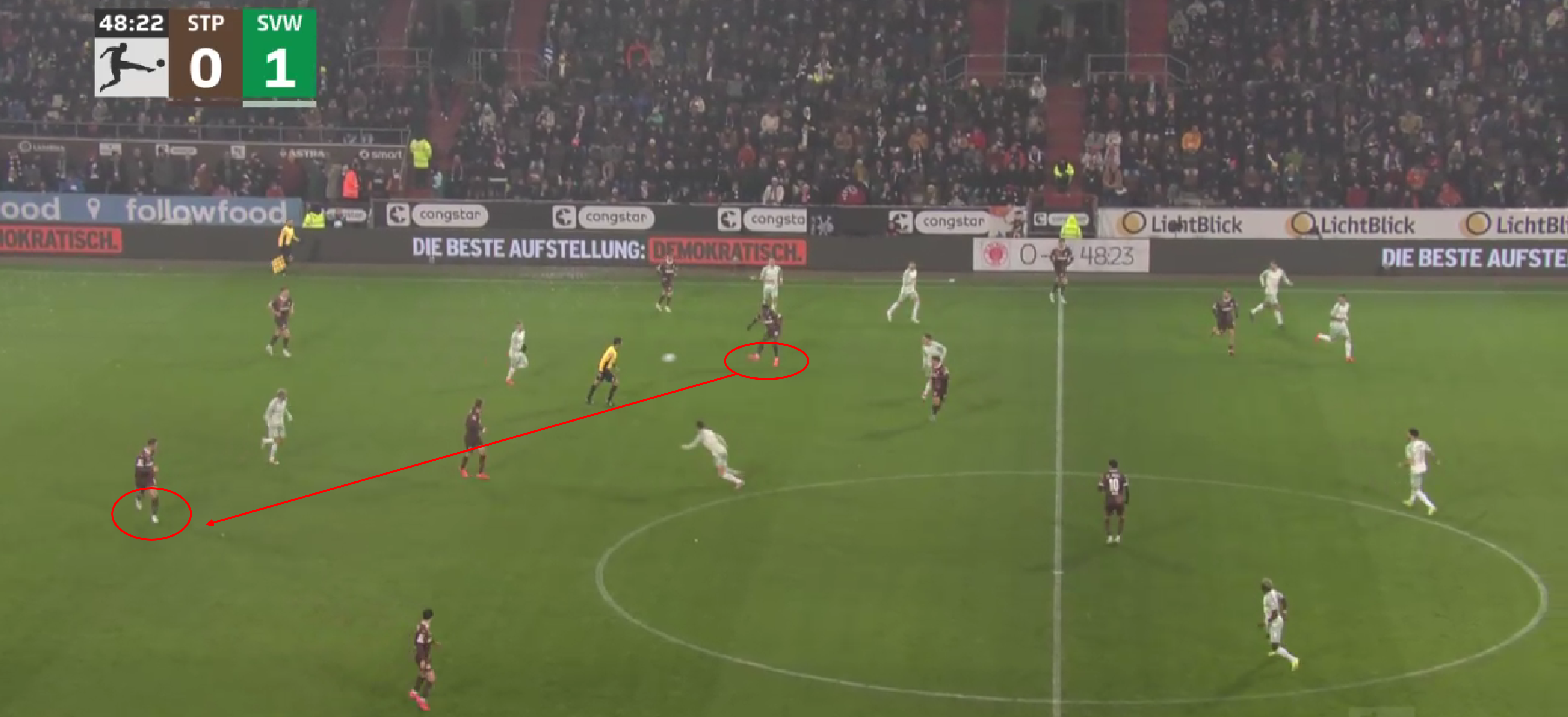
Unfortunately for them, they are not very good at it.
St. Pauli got pressed here and was not able to play a vertical pass and lost the ball twice here already but managed to recover twice as well.
Now, they are in condensed space and simply do not find solutions.
The players’ body positions are less than ideal, their movement is not good, and their passing is not good enough.
Still, they can retain possession in these situations; Blessin still gives them opportunities in the form of a switch that is played here, but backwards.
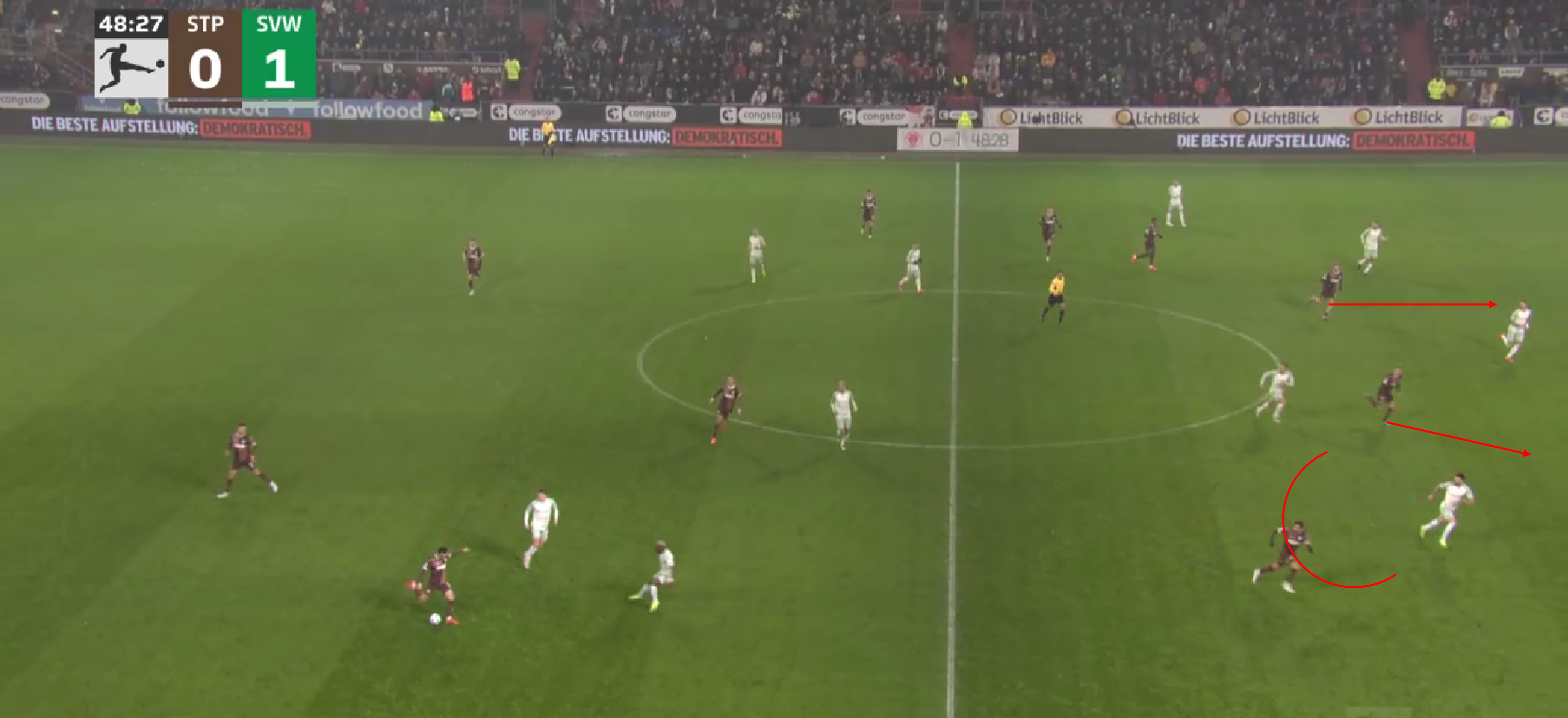
Once again, the team is doing very well.
With their manpower in the attacking line, the team is looking for deep runs when their wing-backs receive the ball in deep positions.
These runs are coordinated and timed very well, the nearest attacker is not moving straight forward, but instead arches his run and drags one centre-back out of the backline.
The other two attackers now make diagonal runs into the gaps between the defenders and, therefore, are very hard for the defenders to grasp.
Johannes Eggestein was freed up that way twice in about five minutes in this game.
Still, one time, Saliakas overhit the pass, and one time, Eggestein was unable to control the ball, and that’s the most crucial point: while the basic concepts are good, the players are not good enough at this level.
Even with time, there are way too many bad decisions, and the execution is lacking in pretty much all footballing actions performed in the attacking third, which is the reason for their attacking struggles.
Blessin has already given his team a bunch of easy concepts in possession, now he needs to hand them easier to execute solutions there as well.
Positive Signs?
Still, there are a couple of positive things that Alexander Blessin has done in the attack for St. Pauli.
The team has never been truly elite going forward.
Even in the season that got them promoted, they scored the fewest goals among the top five clubs in the league table.
After the promotion, it was obvious that St. Pauli could not maintain its dominant and controlled playstyle.
The club would be the underdog in most games and would need to adjust accordingly.
Hence, the club’s decision to sign a Red Bull-type coach was a good one.
That said, the team has been rather decent on the counterattack this season.
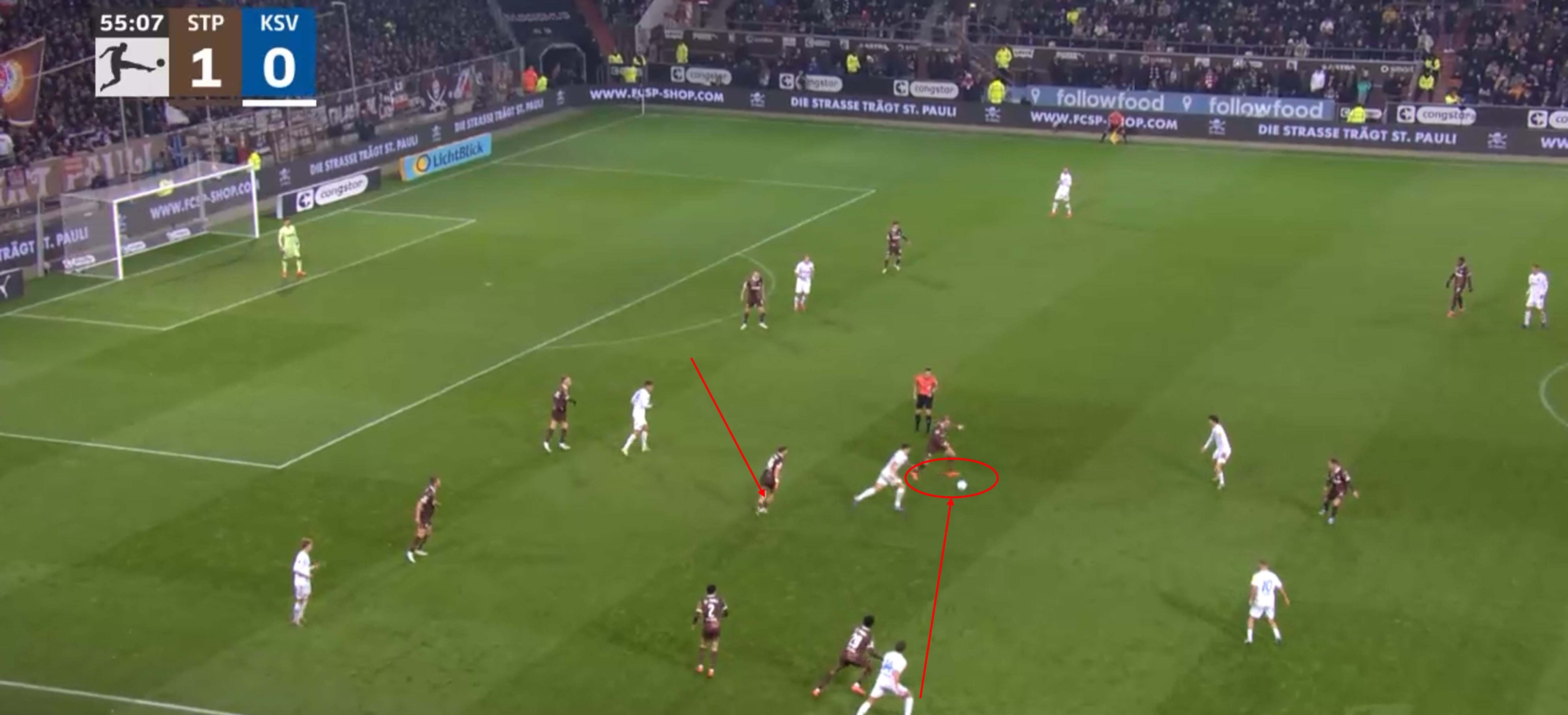
Here, we can see a very typical situation for St. Pauli this season.
The team is defending in a deep block and pressing well.
Here, Smith is moving into midfield again, bringing a lot of pressure to the Kiel attackers.
This leads to a very bad pass by the Kiel full-back and an interception by Irvine.
Now, Irvine can instantly carry the ball forward and pass it to Afolayan, who can instantly turn towards the goal in half-space.
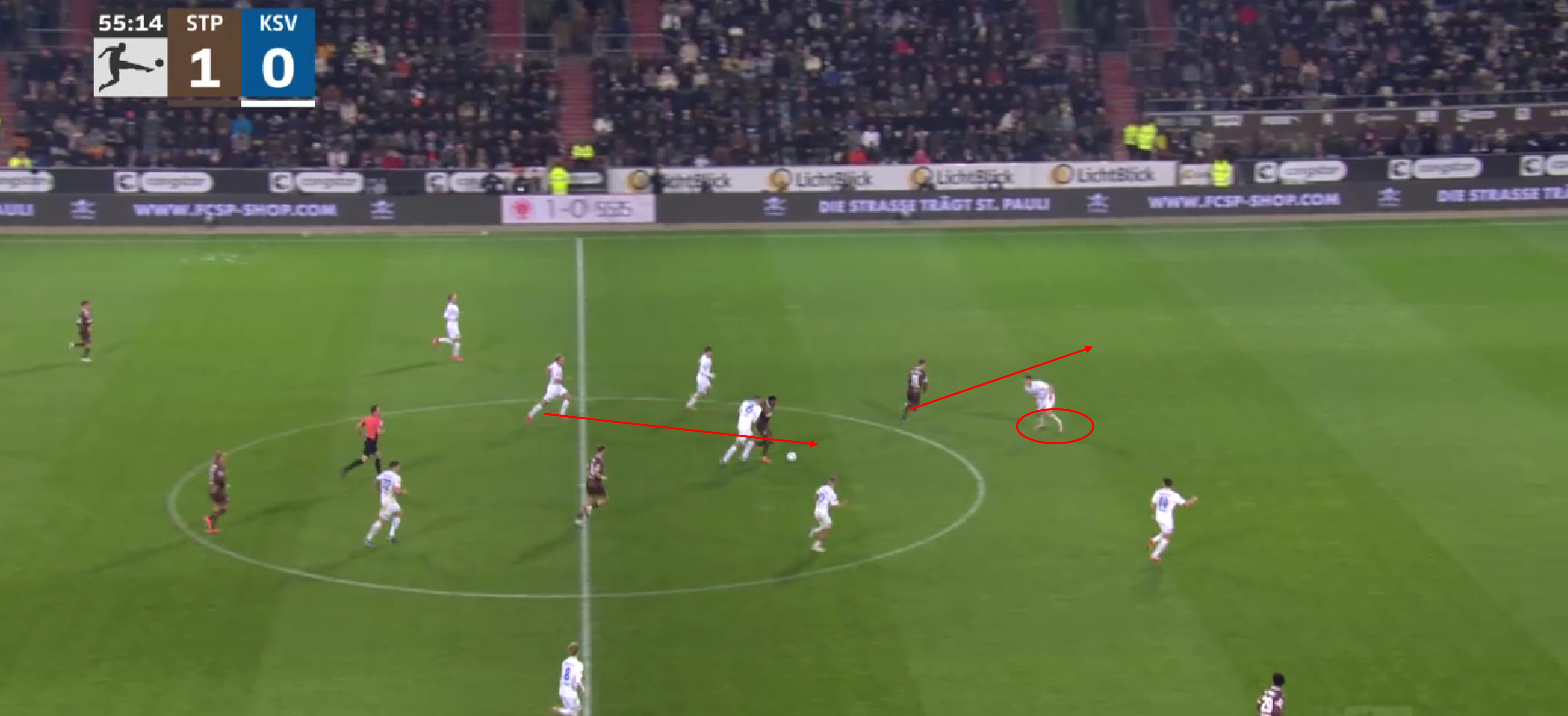
Now, we can see Afolayan’s individual qualities, as he is very good at dribbling past the midfield in these situations.
Here, he manages to beat out three Kiel midfielders, which creates a situation where he is running towards the backline now.
Kiel’s right centre-back is now in a bad situation.
He needs to move forward to cover the dribble, but Johannes Eggestein makes the perfect run to the outside and behind that defender, which is exactly what Blessin brought to the team.
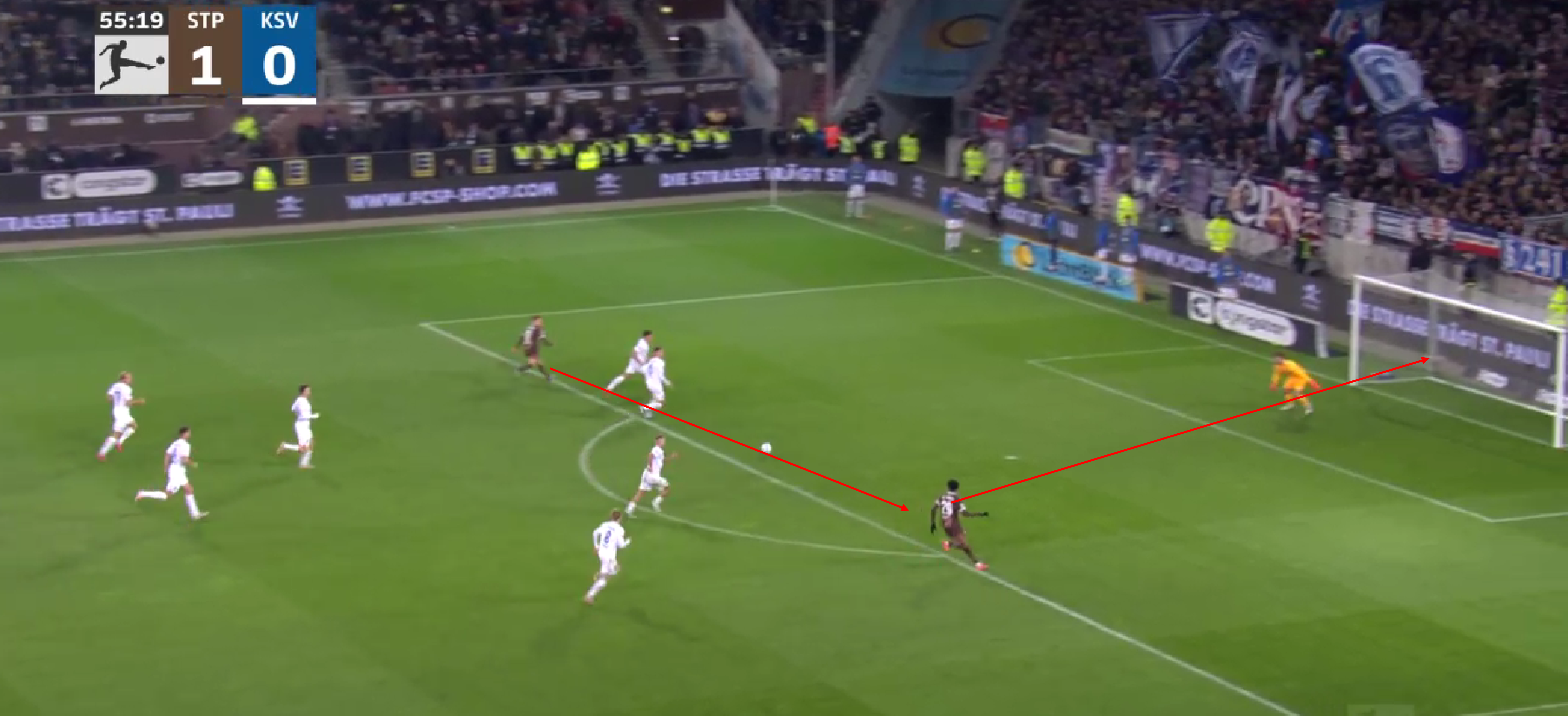
Now, Afolayan simply needs to pass to Eggestein, who squares the ball, resulting in an easy finish for St. Pauli.
In the last couple of games, St. Pauli has seen more of these very fast and well-coordinated counterattacks.
However, because they are not getting many leads, Alexander Blessin’s good work here is often overshadowed by their lack of quality in possession.
Conclusion
In the end, watching FC St. Pauli play is honestly a bit frustrating so far this season.
The team is doing so many things the right way, especially their attacking press and counterpress is really good.
Their coach, Alexander Blessin, has given his team a broad variety of solutions in all situations.
With his Red Bull-influenced past, St. Pauli have been exceptional against the ball.
They are always active and adjust their tactics according to the opponent they face.
They can also defend in a deep block, making them one of the best statistical defences in the Bundesliga this season.
Their build-up play is clever, too, and they are doing very well there.
Blessin has now proven that he is more than just a pressing coach and is able to establish more than just basic principles in possession.
However, their attacking play out of possession is lacking, and it’s not nice.
Overall, the team lacks individual class and is paying the price for it in a very good Bundesliga this year.
Regardless of how the season ends for the club, Alexander Blessin has proven to be a good coach again, this time in a top league after his failure in Italy.
He will have a prosperous career as a coach, and therefore, tiny SV Bonlanden will continue to make an impact on the big stage of world football.

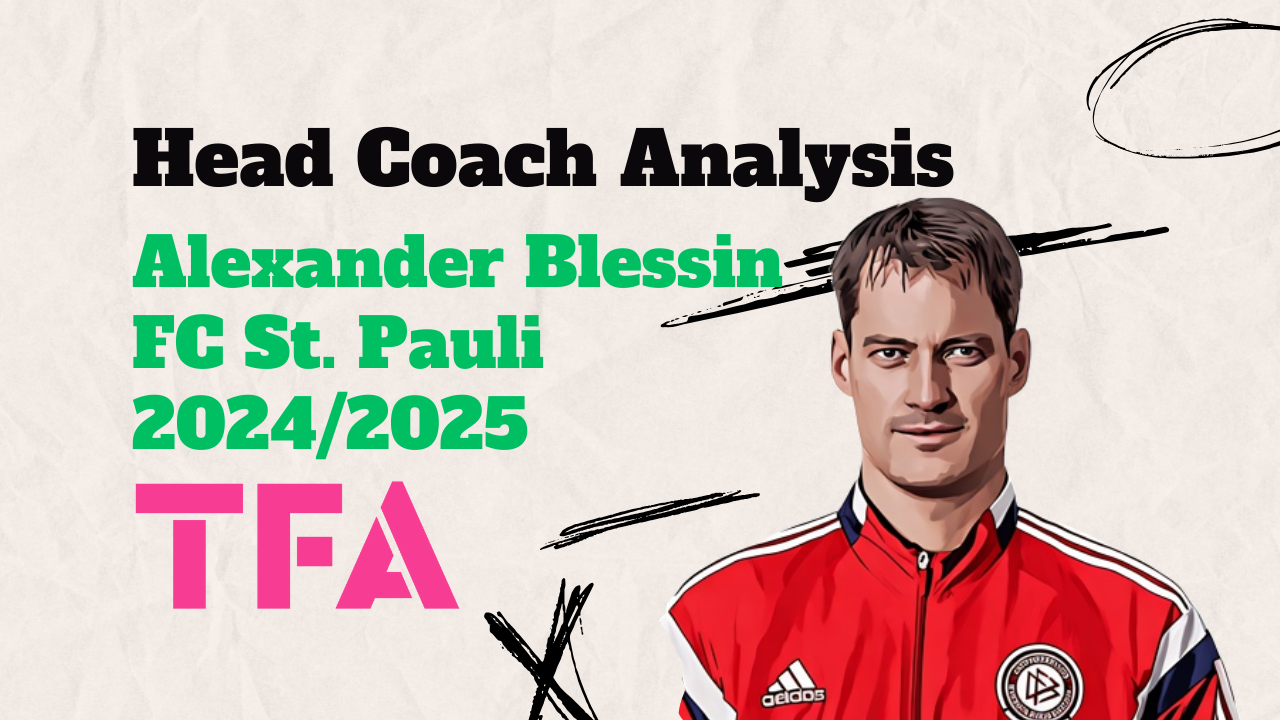




Comments